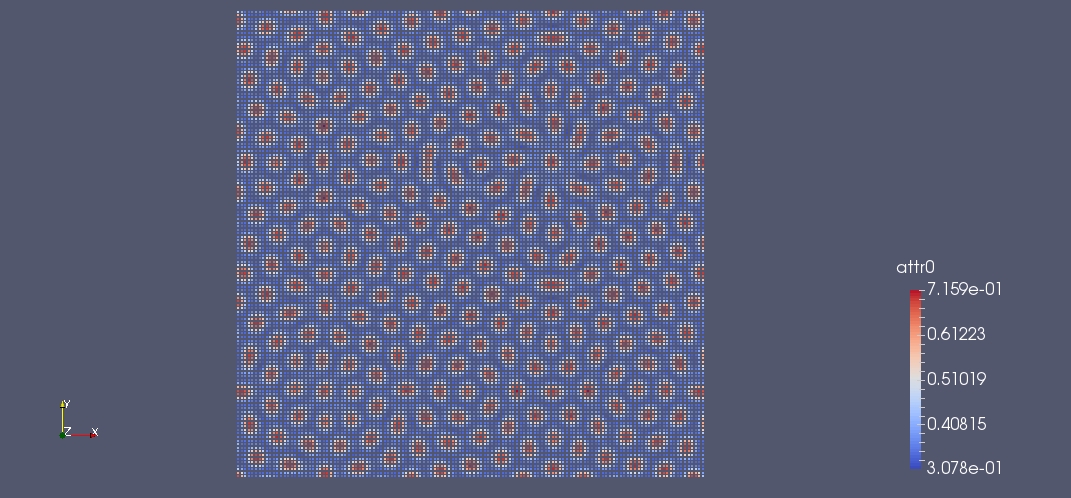Solving a gray scott-system
This example show the usage of periodic grid with ghost part given in grid units to solve the following system of equations
\(\frac{\partial u}{\partial t} = D_u \nabla^{2} u - uv^2 + F(1-u)\)
\(\frac{\partial v}{\partial t} = D_v \nabla^{2} v + uv^2 - (F + k)v\)
Constants and functions
First we define convenient constants
constexpr int U = 0;
constexpr int V = 1;
constexpr int x = 0;
constexpr int y = 1;
We also define an init function. This function initialize the species U and V. In the following we are going into the detail of this function
In figure is the final solution of the problem

Here we initialize for the full domain. U and V itarating across the grid points. For the calculation We are using 2 grids one Old and New. We initialize Old with the initial condition concentration of the species U = 1 over all the domain and concentration of the specie V = 0 over all the domain. While the New grid is initialized to 0
auto it = Old.getDomainIterator();
while (it.isNext())
{
Old.template get<U>(
key) = 1.0;
Old.template get<V>(
key) = 0.0;
New.template get<U>(
key) = 0.0;
New.template get<V>(
key) = 0.0;
++it;
}
After we initialized the full grid, we create a perturbation in the domain with different values. We do in the part of space: 1.55 < x < 1.85 and 1.55 < y < 1.85. Or more precisely on the points included in this part of space.
grid_key_dx<2> start({(
long int)std::floor(Old.size(0)*1.55f/domain.
getHigh(0)),(
long int)std::floor(Old.size(1)*1.55f/domain.
getHigh(1))});
grid_key_dx<2> stop ({(
long int)std::ceil (Old.size(0)*1.85f/domain.
getHigh(0)),(
long int)std::ceil (Old.size(1)*1.85f/domain.
getHigh(1))});
auto it_init = Old.getSubDomainIterator(start,stop);
while (it_init.isNext())
{
Old.template get<U>(
key) = 0.5 + (((
double)std::rand())/RAND_MAX -0.5)/100.0;
Old.template get<V>(
key) = 0.25 + (((
double)std::rand())/RAND_MAX -0.5)/200.0;
++it_init;
}
Initialization
Initialize the library
Create
- A 2D box that define the domain
- an array of 2 unsigned integer that will define the size of the grid on each dimension
- Periodicity of the grid
- A Ghost object that will define the extension of the ghost part for each sub-domain in grid point unit
We also define numerical and physical parameters
- Time stepping for the integration
- Diffusion constant for the species u
- Diffusion constant for the species v
- Number of time-steps
- Physical constant K
- Physical constant F
openfpm_init(&argc,&argv);
size_t sz[2] = {128,128};
double deltaT = 1;
double du = 2*1e-5;
double dv = 1*1e-5;
size_t timeSteps = 15000;
double K = 0.055;
double F = 0.03;
Here we create 2 distributed grid in 2D Old and New. In particular because we want that the second grid is distributed across processors in the same way we pass the decomposition of the Old grid to the New one in the constructor with Old.getDecomposition(). Doing this, we force the two grid to have the same decomposition.
double spacing[2] = {Old.
spacing(0),Old.spacing(1)};
We use the function init to initialize U and V on the grid Old
Time stepping
After initialization, we first synchronize the ghost part of the species U and V for the grid, that we are going to read (Old). In the next we are going to do 15000 time steps using Eulerian integration
Because the update step of the Laplacian operator from \( \frac{\partial u}{\partial t} = \nabla u + ... \) discretized with eulerian time-stepping look like
\( \delta U_{next}(x,y) = \delta t D_u (\frac{U(x+1,y) - 2U(x,y) + U(x-1,y)}{(\delta x)^2} + \frac{U(x,y+1) - 2U(x,y) + U(x,y-1)}{(\delta y)^2}) + ... \)
If \( \delta x = \delta y \) we can simplify with
\( U_{next}(x,y) = \frac{\delta t D_u}{(\delta x)^2} (U(x+1,y) + U(x-1,y) + U(x,y-1) + U(x,y+1) -4U(x,y)) + ... \) (Eq 2)
The specie V follow the same concept while for the \( ... \) it simply expand into
\( - \delta t uv^2 - \delta t F(U - 1.0) \)
and V the same concept
- See Also
- Ghost
-
Loop over grid points
-
Grid coordinates
-
VTK and visualization
size_t count = 0;
Old.template ghost_get<U,V>();
double uFactor = deltaT * du/(spacing[x]*spacing[x]);
double vFactor = deltaT * dv/(spacing[x]*spacing[x]);
for (size_t i = 0; i < timeSteps; ++i)
{
auto it = Old.getDomainIterator();
while (it.isNext())
{
New.get<U>(
key) = Old.get<U>(
key) + uFactor * (
Old.get<U>(
key.move(x,1)) +
Old.get<U>(
key.move(x,-1)) +
Old.get<U>(
key.move(y,1)) +
Old.get<U>(
key.move(y,-1)) +
- deltaT * Old.get<U>(
key) * Old.get<V>(
key) * Old.get<V>(
key) +
- deltaT * F * (Old.get<U>(
key) - 1.0);
New.get<V>(
key) = Old.get<V>(
key) + vFactor * (
Old.get<V>(
key.move(x,1)) +
Old.get<V>(
key.move(x,-1)) +
Old.get<V>(
key.move(y,1)) +
Old.get<V>(
key.move(y,-1)) -
deltaT * Old.get<U>(
key) * Old.get<V>(
key) * Old.get<V>(
key) +
- deltaT * (F+K) * Old.get<V>(
key);
++it;
}
Old.copy(New);
Old.ghost_get<U,V>();
if (i % 100 == 0)
{
Old.write_frame("output",count);
count++;
}
}
Finalize
Deinitialize the library
